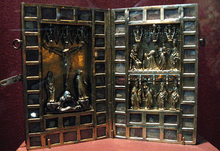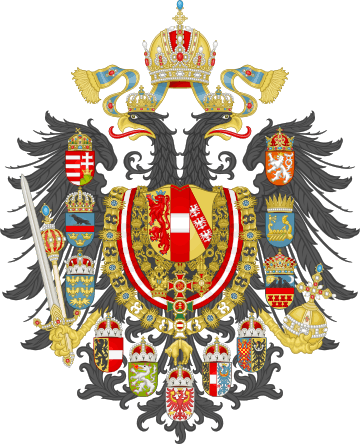Teutonic Order
The Order of Brothers of the German House of Saint Mary in Jerusalem[2] (official names: Latin: Ordo domus Sanctæ Mariæ Theutonicorum Hierosolymitanorum, German: Orden der Brüder vom Deutschen Haus der Heiligen Maria in Jerusalem), commonly the Teutonic Order (Deutscher Orden, Deutschherrenorden or Deutschritterorden), is a Catholic religious order founded as a military order c. 1192 in Acre, Kingdom of Jerusalem.
| Order of Brothers of the German House of Saint Mary in Jerusalem | |
|---|---|
 Coat of arms in the style of the 14th-century | |
| Active | c. 1192 – present |
| Allegiance | |
| Type | Catholic religious order (1192–1929 as military order) |
| Headquarters |
|
| Nickname(s) | Teutonic Knights, German Order |
| Patron |
|
| Attire | White mantle with a black cross |
| Commanders | |
| First Grand Master | Heinrich Walpot von Bassenheim |
| Current Grand Master | Frank Bayard[1] |
The Teutonic Order was formed to aid Christians on their pilgrimages to the Holy Land and to establish hospitals. Its members have commonly been known as the Teutonic Knights, having a small voluntary and mercenary military membership, serving as a crusading military order for protection of Christians in the Holy Land and the Baltics during the Middle Ages.
Purely religious since 1810, the Teutonic Order still confers limited honorary knighthoods.[3] The Bailiwick of Utrecht of the Teutonic Order, a Protestant chivalric order, is descended from the same medieval military order and also continues to award knighthoods and perform charitable work.[4]
Name
The full name of the Order in German is Orden der Brüder vom Deutschen Haus St. Mariens in Jerusalem or in Latin Ordo domus Sanctæ Mariæ Theutonicorum Hierosolymitanorum (engl. "Order of the House of St. Mary of the Germans in Jerusalem"). Thus the term "Teutonic" echoes the German origins of the order (Theutonicorum) in its Latin name.[5] It is commonly known in German as the Deutscher Orden (official short name, literally "German Order"), historically also as Deutscher Ritterorden ("German Order of Knights"), Deutschherrenorden, Deutschritterorden ("Order of the German Knights"), Marienritter ("Knights of Mary"), Die Herren im weißen Mantel ("The lords in white capes"), etc.
The Teutonic Knights have been known as Zakon Krzyżacki in Polish ("Order of the Cross") and as Kryžiuočių Ordinas in Lithuanian, Vācu Ordenis in Latvian, Saksa Ordu or, simply, Ordu ("The Order") in Estonian, as well as various names in other languages.
History
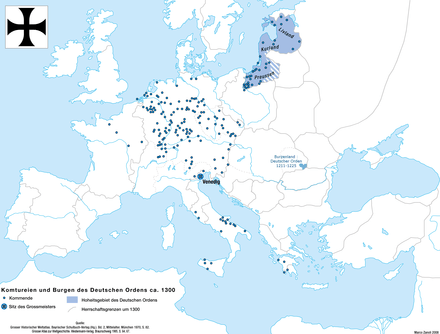
Formed in the year 1192 in Acre, in the Levant, the medieval Order played an important role in Outremer (the general name for the Crusader states), controlling the port tolls of Acre. After Christian forces were defeated in the Middle East, the Order moved to Transylvania in 1211 to help defend the South-Eastern borders of the Kingdom of Hungary against the Cumans. The Knights were expelled by force of arms by King Andrew II of Hungary in 1225, after attempting to place themselves under papal instead of the original Hungarian sovereignty and thus to become independent.[6]
In 1230, following the Golden Bull of Rimini, Grand Master Hermann von Salza and Duke Konrad I of Masovia launched the Prussian Crusade, a joint invasion of Prussia intended to Christianize the Baltic Old Prussians. The Knights had quickly taken steps against their Polish hosts and with the Holy Roman Emperor's support, had changed the status of Chełmno Land (also Ziemia Chelminska or Kulmerland), where they were invited by the Polish prince, into their own property. Starting from there, the Order created the independent Monastic State of the Teutonic Knights, adding continuously the conquered Prussians' territory, and subsequently conquered Livonia. Over time, the kings of Poland denounced the Order for expropriating their lands, specifically Chełmno Land and later the Polish lands of Pomerelia (also Pomorze Gdańskie or Pomerania), Kujawy, and Dobrzyń Land.
The Order theoretically lost its main purpose in Europe with the Christianization of Lithuania. However, it initiated numerous campaigns against its Christian neighbours, the Kingdom of Poland, the Grand Duchy of Lithuania, and the Novgorod Republic (after assimilating the Livonian Order). The Teutonic Knights had a strong economic base which enabled them to hire mercenaries from throughout Europe to augment their feudal levies, and they also became a naval power in the Baltic Sea. In 1410, a Polish-Lithuanian army decisively defeated the Order and broke its military power at the Battle of Grunwald (Tannenberg). However, the capital of the Teutonic Knights was successfully defended in the following Siege of Marienburg and the Order was saved from collapse.
In 1515, Holy Roman Emperor Maximilian I made a marriage alliance with Sigismund I of Poland-Lithuania. Thereafter, the empire did not support the Order against Poland. In 1525, Grand Master Albert of Brandenburg resigned and converted to Lutheranism, becoming Duke of Prussia as a vassal of Poland. Soon after, the Order lost Livonia and its holdings in the Protestant areas of Germany.[7] The Order did keep its considerable holdings in Catholic areas of Germany until 1809, when Napoleon Bonaparte ordered its dissolution and the Order lost its last secular holdings.
However, the Order continued to exist as a charitable and ceremonial body. It was outlawed by Adolf Hitler in 1938,[8] but re-established in 1945.[9] Today it operates primarily with charitable aims in Central Europe.
The Knights wore white surcoats with a black cross. A cross pattée was sometimes used as their coat of arms; this image was later used for military decoration and insignia by the Kingdom of Prussia and Germany as the Iron Cross and Pour le Mérite. The motto of the Order was: "Helfen, Wehren, Heilen" ("Help, Defend, Heal").[10]
Timeline
- 1190 Formation
- 1218 Siege of Damietta
- 1228–1229 The Sixth Crusade
- 1237 absorption of The Livonian Brothers of the Sword
- 1242 The Battle on the Ice
- 1242–1249 First Prussian uprising
- 1249 Treaty of Christburg with the pagan Prussians signed on February 9
- 1249 Battle of Krücken
- 1260 Battle of Durbe
- 1260–1274 Great Prussian uprising
- 1262 Siege of Königsberg
- 1263 Battle of Löbau
- 1264 Siege of Bartenstein
- 1270 Battle of Karuse
- 1271 Battle of Pagastin
- 1279 Battle of Aizkraukle
- 1291 Siege of Acre (1291)
- 1308–1309 Teutonic takeover of Danzig and Treaty of Soldin
- 1326–1332 First Polish–Teutonic War, for Kuyavia, with involvement of Lithuania and Hungary
- 1331 Battle of Płowce
- 1343 Treaty of Kalisz, exchange of Kuyavia for Kulm and other territories
- 1343–1345 St. George's Night Uprising
- 1346 Purchase of Duchy of Estonia from Denmark
- 1348 Battle of Strėva
- 1370 Battle of Rudau
- 1409–1411 Polish–Lithuanian–Teutonic War, the Teutonic knights are defeated by Polish king Władysław II Jagiełło and Lithuanian Grand duke Vytautas the Great at the Battle of Grunwald (Tannenberg) (1410)
- 1414 Hunger War
- 1422 Gollub War ending with the Treaty of Melno
- 1431–1435 Second Polish–Teutonic War
- 1454–1466 Thirteen Years' War
- 1466 Second Peace of Thorn (1466)
- 1467–1479 War of the Priests
- 1519–1521 Third Polish–Teutonic War
- 1525 the Livonian Order buys itself de facto independent from the Teutonic Order
- 1525 Order loses State of the Teutonic Order due to the Prussian Homage, it becomes Ducal Prussia
Foundation
In 1143 Pope Celestine II ordered the Knights Hospitaller to take over management of a German hospital in Jerusalem, which, according to the chronicler Jean d’Ypres, accommodated the countless German pilgrims and crusaders who could neither speak the local language nor Latin (patriæ linguam ignorantibus atque Latinam).[11] Although formally an institution of the Hospitallers, the pope commanded that the prior and the brothers of the domus Theutonicorum (house of the Germans) should always be Germans themselves, so a tradition of a German-led religious institution could develop during the 12th century in the Kingdom of Jerusalem.[12]
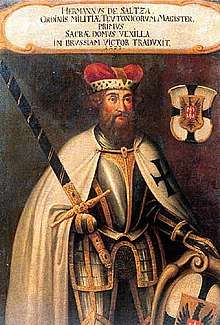
After the loss of Jerusalem in 1187, some merchants from Lübeck and Bremen took up the idea and founded a field hospital for the duration of the Siege of Acre in 1190, which became the nucleus of the order; Celestine III recognized it in 1192 by granting the monks Augustinian Rule. However, based on the model of the Knights Templar, it was transformed into a military order in 1198 and the head of the order became known as the Grand Master (magister hospitalis). It received papal orders for crusades to take and hold Jerusalem for Christianity and defend the Holy Land against the Muslim Saracens. During the rule of Grand Master Hermann von Salza (1209–1239) the Order changed from being a hospice brotherhood for pilgrims to primarily a military order.
The Order was founded in Acre, and the Knights purchased Montfort (Starkenberg), northeast of Acre, in 1220. This castle, which defended the route between Jerusalem and the Mediterranean Sea, was made the seat of the Grand Masters in 1229, although they returned to Acre after losing Montfort to Muslim control in 1271. The Order also had a castle at Amouda in Armenia Minor. The Order received donations of land in the Holy Roman Empire (especially in present-day Germany and Italy), Frankish Greece, and the Kingdom of Jerusalem.
Emperor Frederick II elevated his close friend Hermann von Salza to the status of Reichsfürst, or "Prince of the Empire", enabling the Grand Master to negotiate with other senior princes as an equal. During Frederick's coronation as King of Jerusalem in 1225, Teutonic Knights served as his escort in the Church of the Holy Sepulchre; von Salza read the emperor's proclamation in both French and German. However, the Teutonic Knights were never as influential in Outremer as the older Templars and Hospitallers.
Transylvania, Kingdom of Hungary
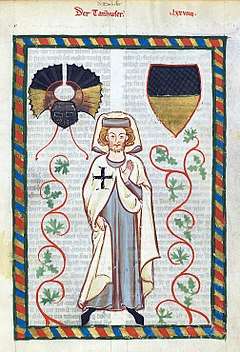
In 1211, Andrew II of Hungary accepted the services of the Teutonic Knights and granted them the district of Burzenland in Transylvania, where they would be immune to fees and duties and could enforce their own justice. Andrew had been involved in negotiations for the marriage of his daughter with the son of Hermann, Landgrave of Thuringia, whose vassals included the family of Hermann von Salza. Led by a brother called Theoderich or Dietrich, the Order defended the south-eastern borders of the Kingdom of Hungary against the neighbouring Cumans. Many forts of wood and mud were built for defence. They settled new German peasants among the existing Transylvanian Saxon inhabitants. The Cumans had no fixed settlements for resistance, and soon the Teutons were expanding into their territory. By 1220, The Teutonics Knights had built five castles, some of them made of stone. Their rapid expansion made the Hungarian nobility and clergy, who were previously uninterested in those regions, jealous and suspicious. Some nobles claimed these lands, but the Order refused to share them, ignoring the demands of the local bishop. After the Fifth Crusade, King Andrew returned to Hungary and found his kingdom full of grudge because of the expenses and losses of the failed military campaign. When the nobles demanded that he cancel the concessions made to the Knights, he concluded that they had exceeded their task and that the agreement should be revised, but did not revert the concessions. However, Prince Béla, heir to the throne, was allied with the nobility. In 1224, the Teutonic Knights, seeing that they would have problems when the Prince inherited the Kingdom, petitioned Pope Honorius III to be placed directly under the authority of the Papal See, rather than that of the King of Hungary. This was a grave mistake, as King Andrew, angered and alarmed at their growing power, responded by expelling the Teutonic Knights in 1225, although he allowed the ethnically German commoners and peasants settled here by the Order and who became part of the larger group of the Transylvanian Saxons, to remain. Lacking the military organization and experience of the Teutonic Knights, the Hungarians did not replace them with adequate defenders which had prevented the attacking Cumans. Soon, the steppe warriors would be a threat again.[13]
Prussia
In 1226, Konrad I, Duke of Masovia in north-eastern Poland, appealed to the Knights to defend his borders and subdue the pagan Baltic Old Prussians, allowing the Teutonic Knights use of Chełmno Land (Culmerland) as a base for their campaign. This being a time of widespread crusading fervor throughout Western Europe, Hermann von Salza considered Prussia a good training ground for his knights for the wars against the Muslims in Outremer.[14] With the Golden Bull of Rimini, Emperor Frederick II bestowed on the Order a special imperial privilege for the conquest and possession of Prussia, including Chełmno Land, with nominal papal sovereignty. In 1235 the Teutonic Knights assimilated the smaller Order of Dobrzyń, which had been established earlier by Christian, the first Bishop of Prussia.

The conquest of Prussia was accomplished with much bloodshed over more than fifty years, during which native Prussians who remained unbaptised were subjugated, killed, or exiled. Fighting between the Knights and the Prussians was ferocious; chronicles of the Order state the Prussians would "roast captured brethren alive in their armour, like chestnuts, before the shrine of a local god".[15]
The native nobility who submitted to the crusaders had many of their privileges affirmed in the Treaty of Christburg. After the Prussian uprisings of 1260–83, however, much of the Prussian nobility emigrated or were resettled, and many free Prussians lost their rights. The Prussian nobles who remained were more closely allied with the German landowners and gradually assimilated.[16] Peasants in frontier regions, such as Samland, had more privileges than those in more populated lands, such as Pomesania.[17] The crusading knights often accepted baptism as a form of submission by the natives.[18] Christianity along western lines slowly spread through Prussian culture. Bishops were reluctant to have Prussian religious practices integrated into the new faith,[19] while the ruling knights found it easier to govern the natives when they were semi-pagan and lawless.[20] After fifty years of warfare and brutal conquest, the end result meant that most of the Prussian natives were either killed or deported.[21]
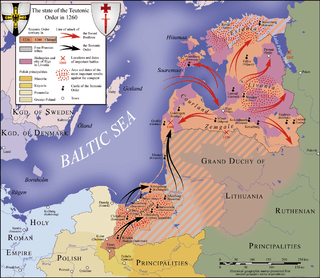
The Order ruled Prussia under charters issued by the Pope and the Holy Roman Emperor as a sovereign monastic state, comparable to the arrangement of the Knights Hospitallers in Rhodes and later in Malta.
To make up for losses from the plague and to replace the partially exterminated native population, the Order encouraged immigration from the Holy Roman Empire (mostly Germans, Flemish, and Dutch) and from Masovia (Poles), the later Masurians. These included nobles, burghers, and peasants, and the surviving Old Prussians were gradually assimilated through Germanization. The settlers founded numerous towns and cities on former Prussian settlements. The Order itself built a number of castles (Ordensburgen) from which it could defeat uprisings of Old Prussians, as well as continue its attacks on the Grand Duchy of Lithuania and the Kingdom of Poland, with which the Order was often at war during the 14th and 15th centuries. Major towns founded by the Order included Allenstein (Olsztyn), Elbing (Elbląg), Klaipėda (Memel), and Königsberg, founded in 1255 in honor of King Otakar II of Bohemia on the site of a destroyed Prussian settlement.
Livonia
The Livonian Brothers of the Sword were absorbed by the Teutonic Knights in 1237, after the former had suffered a devastating defeat in the Battle of Saule. The Livonian branch subsequently became known as the Livonian Order.[22] Attempts to expand into Rus' failed when the knights suffered a major defeat in 1242 in the Battle of the Ice at the hands of Prince Alexander Nevsky of Novgorod. Over the next decades the Order focused on the subjugation of the Curonians and Semigallians. In 1260 it suffered a disastrous defeat in the Battle of Durbe against Samogitians, which inspired rebellions throughout Prussia and Livonia. After the Teutonic Knights won a crucial victory in the Siege of Königsberg from 1262 to 1265, the war had reached a turning point. The Curonians were finally subjugated in 1267 and the Semigallians in 1290.[22] The Order suppressed a major Estonian rebellion in 1343–1345, and in 1346 purchased the Duchy of Estonia from Denmark.
Against Lithuania
The Teutonic Knights began to direct their campaigns against pagan Lithuania (see Lithuanian mythology), due to the long existing conflicts in the region (including constant incursions into the Holy Roman Empire's territory by pagan raiding parties) and the lack of a proper area of operation for the Knights, after the fall of the Kingdom of Jerusalem at Acre in 1291 and their later expulsion from Hungary.[23] At first the knights moved their headquarters to Venice, from which they planned the recovery of Outremer,[24] this plan was, however, shortly abandoned, and the Order later moved its headquarters to Marienburg, so it could better focus its efforts on the region of Prussia. Because "Lithuania Propria" remained non-Christian until the end of the 14th century, much later than the rest of eastern Europe, the conflicts stretched out for a longer time, and many Knights from western European countries, such as England and France, journeyed to Prussia to participate in the seasonal campaigns (reyse) against the Grand Duchy of Lithuania. In 1348, the Order won a great victory over the Lithuanians in the Battle of Strėva, severely weakening them. The Teutonic Knights won a decisive victory over Lithuania in the Battle of Rudau in 1370.
Warfare between the Order and the Lithuanians was especially brutal. It was common practice for Lithuanians to torture captured enemies and civilians, it is recorded by a Teutonic chronicler that they had the habit of tying captured Knights to their horses and having both of them burned alive, while sometimes a stake would be driven into their bodies, or the Knight would be flayed. Lithuanian pagan customs included ritualistic human sacrifice, the hanging of widows, and the burying of a warrior's horses and servants with him after his death.[25] The Knights would also, on occasion, take captives from defeated Lithuanians, whose condition (as that of other war captives in the Middle Ages) was extensively researched by Jacques Heers.[26] The conflict had much influence in the political situation of the region, and was the source of many rivalries between Lithuanians or Poles and Germans, the degree to which it impacted the mentalities of the time can be seen in the lyrical works of men such as the contemporary Austrian poet Peter Suchenwirt.
The conflict in its entirety lasted over 200 years (although with varying degrees of aggression during that time), with its front line along both banks of the Neman River, with as many as twenty forts and castles between Seredžius and Jurbarkas alone.
Against Poland
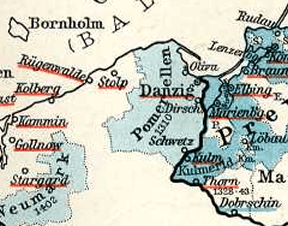
A dispute over the succession to the Duchy of Pomerelia embroiled the Order in further conflict at the beginning of the 14th century. The Margraves of Brandenburg had claims to the duchy that they acted upon after the death of King Wenceslaus of Poland in 1306. Duke Władysław I the Elbow-high of Poland also claimed the duchy, based on inheritance from Przemysław II, but he was opposed by some Pomeranians nobles. They requested help from Brandenburg, which subsequently occupied all of Pomerelia except for the citadel of Danzig (Gdańsk) in 1308. Because Władysław was unable to come to the defense of Danzig, the Teutonic Knights, then led by Hochmeister Siegfried von Feuchtwangen, were called to expel the Brandenburgers.
The Order, under a Prussian Landmeister Heinrich von Plötzke, evicted the Brandenburgers from Danzig in September 1308 but then refused to yield the town to the Poles, and according to some sources massacred the town's inhabitants; although the exact extent of the violence is unknown, and widely recognized by historians to be an unsolvable mystery. The estimates range from 60 rebellious leaders, reported by dignitaries of the region and Knight chroniclers, to 10,000 civilians, a number cited in a papal bull (of dubious provenance) that was used in a legal process installed to punish the Order for the event; the legal dispute went on for a time, but the Order was eventually absolved of the charges. In the Treaty of Soldin, the Teutonic Order purchased Brandenburg's supposed claim to the castles of Danzig, Schwetz (Świecie), and Dirschau (Tczew) and their hinterlands from the margraves for 10,000 marks on 13 September 1309.[27]
Control of Pomerelia allowed the Order to connect their monastic state with the borders of the Holy Roman Empire. Crusading reinforcements and supplies could travel from the Imperial territory of Hither Pomerania through Pomerelia to Prussia, while Poland's access to the Baltic Sea was blocked. While Poland had mostly been an ally of the knights against the pagan Prussians and Lithuanians, the capture of Pomerelia turned the kingdom into a determined enemy of the Order.[28]
The capture of Danzig marked a new phase in the history of the Teutonic Knights. The persecution and abolition of the powerful Knights Templar, which began in 1307, worried the Teutonic Knights, but control of Pomerelia allowed them to move their headquarters in 1309 from Venice to Marienburg (Malbork) on the Nogat River, outside the reach of secular powers. The position of Prussian Landmeister was merged with that of the Grand Master. The Pope began investigating misconduct by the knights, but no charges were found to have substance. Along with the campaigns against the Lithuanians, the knights faced a vengeful Poland and legal threats from the Papacy.[29]
The Treaty of Kalisz of 1343 ended open war between the Teutonic Knights and Poland. The Knights relinquished Kuyavia and Dobrzyń Land to Poland, but retained Culmerland and Pomerelia with Danzig.
Defeat by the Mongols
In 1236, the Knights of Saint Thomas, an English order, adopted the rules of the Teutonic Order. A contingent of Teutonic Knights of indeterminate number is traditionally believed to have participated at the Battle of Legnica in 1241 against the Mongols. The combined German-Polish/Lithuanian force was crushed by the Mongol army and their superior tactics, with few survivors.[30][31][32]
Height of power
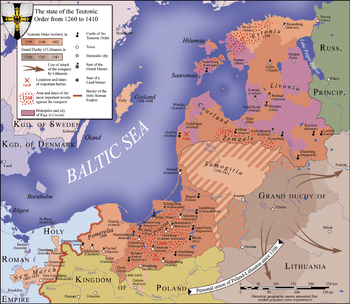
In 1337, Emperor Louis IV allegedly granted the Order the imperial privilege to conquer all Lithuania and Russia. During the reign of Grand Master Winrich von Kniprode (1351–1382), the Order reached the peak of its international prestige and hosted numerous European crusaders and nobility.
King Albert of Sweden ceded Gotland to the Order as a pledge (similar to a fiefdom), with the understanding that they would eliminate the pirating Victual Brothers from this strategic island base in the Baltic Sea. An invasion force under Grand Master Konrad von Jungingen conquered the island in 1398 and drove the Victual Brothers out of Gotland and the Baltic Sea.
In 1386, Grand Duke Jogaila of Lithuania was baptised into Christianity and married Queen Jadwiga of Poland, taking the name Władysław II Jagiełło and becoming King of Poland. This created a personal union between the two countries and a potentially formidable opponent for the Teutonic Knights. The Order initially managed to play Jogaila and his cousin Vytautas against each other, but this strategy failed when Vytautas began to suspect that the Order was planning to annex parts of his territory.
The baptism of Jogaila began the official conversion of Lithuania to Christianity. Although the crusading rationale for the Order's state ended when Prussia and Lithuania had become officially Christian, the Order's feuds and wars with Lithuania and Poland continued. The Lizard Union was created in 1397 by Prussian nobles in Culmerland to oppose the Order's policy.
In 1407, the Teutonic Order reached its greatest territorial extent and included the lands of Prussia, Pomerelia, Samogitia, Courland, Livonia, Estonia, Gotland, Dagö, Ösel, and the Neumark, pawned by Brandenburg in 1402.
Decline
In 1410, at the Battle of Grunwald (German: Schlacht bei Tannenberg) – known in Lithuanian as the Battle of Žalgiris – a combined Polish-Lithuanian army, led by Vytautas and Jogaila, decisively defeated the Order in the Polish-Lithuanian-Teutonic War. Grand Master Ulrich von Jungingen and most of the Order's higher dignitaries fell on the battlefield (50 out of 60). The Polish-Lithuanian army then began the Siege of Marienburg, the capital of the Order, but was unable to take Marienburg owing to the resistance of Heinrich von Plauen. When the First Peace of Thorn was signed in 1411, the Order managed to retain essentially all of its territories, although the Knights' reputation as invincible warriors was irreparably damaged.
While Poland and Lithuania were growing in power, that of the Teutonic Knights dwindled through infighting. They were forced to impose high taxes to pay a substantial indemnity but did not give the cities sufficient requested representation in the administration of their state. The authoritarian and reforming Grand Master Heinrich von Plauen was forced from power and replaced by Michael Küchmeister von Sternberg, but the new Grand Master was unable to revive the Order's fortunes. After the Gollub War the Knights lost some small border regions and renounced all claims to Samogitia in the 1422 Treaty of Melno. Austrian and Bavarian knights feuded with those from the Rhineland, who likewise bickered with Low German-speaking Saxons, from whose ranks the Grand Master was usually chosen. The western Prussian lands of the Vistula River Valley and the Brandenburg Neumark were ravaged by the Hussites during the Hussite Wars.[33] Some Teutonic Knights were sent to battle the invaders, but were defeated by the Bohemian infantry. The Knights also sustained a defeat in the Polish-Teutonic War (1431–1435).
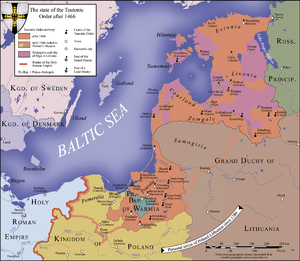
In 1454, the Prussian Confederation, consisting of the gentry and burghers of western Prussia, rose up against the Order, beginning the Thirteen Years' War. Much of Prussia was devastated in the war, during the course of which the Order returned Neumark to Brandenburg in 1455. In the Second Peace of Thorn (1466), the defeated Order recognized the Polish crown's rights over western Prussia (subsequently Royal Prussia) while retaining Teutonic Eastern Prussia, but under Polish suzerainty. Because Marienburg Castle was handed over to mercenaries in lieu of their pay, the Order moved its base to Königsberg in Sambia.
After the Polish–Teutonic War (1519–1521), the Order was completely ousted from Prussia when Grand Master Albert of Brandenburg converted to Lutheranism in 1525. He secularized the Order's remaining Prussian territories and assumed from his uncle Sigismund I the Old, King of Poland, the hereditary rights to the Duchy of Prussia as a vassal of the Polish Crown, the Prussian Homage. The Protestant Duchy of Prussia was thus a fief of Catholic Poland.
Although it had lost control of all of its Prussian lands, the Teutonic Order retained its territories within the Holy Roman Empire and Livonia, although the Livonian branch retained considerable autonomy. Many of the Imperial possessions were ruined in the German Peasants' War from 1524 to 1525 and subsequently confiscated by Protestant territorial princes.[34] The Livonian territory was then partitioned by neighboring powers during the Livonian War; in 1561 the Livonian Master Gotthard Kettler secularized the southern Livonian possessions of the Order to create the Duchy of Courland, also a vassal of Poland.
After the loss of Prussia in 1525, the Teutonic Knights concentrated on their possessions in the Holy Roman Empire. Since they held no contiguous territory, they developed a three-tiered administrative system: holdings were combined into commanderies that were administered by a commander (Komtur). Several commanderies were combined to form a bailiwick headed by a Landkomtur. All of the Teutonic Knights' possessions were subordinate to the Grand Master, whose seat was in Bad Mergentheim.

There were twelve German bailiwicks:
- Thuringia;
- Alden Biesen (in present-day Belgium);
- Hesse;
- Saxony;
- Westphalia;
- Franconia;
- Koblenz;
- Alsace-Burgundy;
- An der Etsch und im Gebirge (in Tyrol);
- Utrecht;
- Lorraine; and
- Austria.
Outside of German areas were the bailiwicks of
- Sicily;
- Apulia;
- Lombardy;
- Bohemia;
- "Romania" (in Greece); and
- Armenia-Cyprus.
The Order gradually lost control of these holdings until, by 1809, only the seat of the Grand Master at Mergentheim remained.
Following the abdication of Albert of Brandenburg, Walter von Cronberg became Deutschmeister in 1527, and later Administrator of Prussia and Grand Master in 1530. Emperor Charles V combined the two positions in 1531, creating the title Hoch- und Deutschmeister, which also had the rank of Prince of the Empire.[35] A new Grand Magistery was established in Mergentheim in Württemberg, which was attacked during the German Peasants' War. The Order also helped Charles V against the Schmalkaldic League. After the Peace of Augsburg in 1555, membership in the Order was open to Protestants, although the majority of brothers remained Catholic.[36] The Teutonic Knights became tri-denominational, with Catholic, Lutheran and Reformed bailiwicks.
The Grand Masters, often members of the great German families (and, after 1761, members of the House of Habsburg-Lorraine), continued to preside over the Order's considerable holdings in Germany. Teutonic Knights from Germany, Austria, and Bohemia were used as battlefield commanders leading mercenaries for the Habsburg Monarchy during the Ottoman wars in Europe.
The military history of the Teutonic Knights was to be ended in 1805 by the Article XII of the Peace of Pressburg, which ordered the German territories of the Knights converted into a hereditary domain and gave the Austrian Emperor responsibility for placing a Habsburg prince on its throne. These terms had not been fulfilled by the time of the Treaty of Schönbrunn in 1809, and therefore Napoleon Bonaparte ordered the Knights' remaining territory to be disbursed to his German allies, which was completed in 1810.
Medieval organisation
Administrative structure about 1350
| Generalkapitel | |||||||||||||||||||||||||||||||||||||||||||
| Ratsgebietiger | Hochmeister | Kanzlei des Hochmeisters | |||||||||||||||||||||||||||||||||||||||||
| Großkomtur (Magnus Commendator) | Ordensmarschall (Summus Marescalcus) | Großspittler (Summus Hospitalarius) | Ordenstressler (Summus Thesaurarius) | Ordenstrappier (Summus Trappearius) | |||||||||||||||||||||||||||||||||||||||
| Großschäffer (Marienburg) | Großschäffer (Königsberg) | ||||||||||||||||||||||||||||||||||||||||||
| Komtur (Preußen) | Komtur (Preußen) | ||||||||||||||||||||||||||||||||||||||||||
| Deutschmeister (Magister Germaniae) | Landmeister in Livland (Magister Livoniae) | ||||||||||||||||||||||||||||||||||||||||||
| Komtur (Livland) | Komtur (Livland) | ||||||||||||||||||||||||||||||||||||||||||
| Landkomtur | Landkomtur | ||||||||||||||||||||||||||||||||||||||||||
| Komtur (in the Holy Empire) | Komtur (in the Holy Empire) | ||||||||||||||||||||||||||||||||||||||||||
| Hauskomtur | Pfleger | Vogt | |||||||||||||||||||||||||||||||||||||||||
| Karwansherr | Trappierer | Kellermeister | Küchenmeister | Wachhauptmann | Gesindemeister | Fischmeister | |||||||||||||||||||||||||||||||||||||
Universal leadership
Generalkapitel
The Generalkapitel (general chapter) was the collection of all the priests, knights and half-brothers (German: Halbbrüder). Because of the logistical problems in assembling the members, who were spread over large distances, only deputations of the bailiwicks and commandries gathered to form the General chapter. The General chapter was designed to meet annually, but the conventions were usually limited to the election of a new Grandmaster. The decisions of the Generalkapitel had a binding effect on the Großgebietigers of the order.
Hochmeister
The Hochmeister (Grandmaster) was the highest officer of the order. Until 1525, he was elected by the Generalkapitel. He had the rank of ruler of an ecclesiastic imperial state and was sovereign prince of Prussia until 1466. Despite this high formal position, practically, he was only a kind of first among equals.
Großgebietiger
The Großgebietiger were high officers with competence on the whole order, appointed by the Hochmeister. There were five offices.
- The Großkomtur (Magnus Commendator), the deputy of the Grandmaster
- The Treßler, the treasurer
- The Spitler (Summus Hospitalarius), responsible for all hospital affairs
- The Trapier, responsible for dressing and armament
- The Marschall (Summus Marescalcus), the chief of military affairs
National leadership
Landmeister
The order was divided in three national chapters, Prussia, Livland and the territory of the Holy Roman Empire of the German Nation. The highest officer of each chapter was the Landmeister (country master). They were elected by the regional chapters. In the beginning, they were only substitutes of the Grandmaster but were able to create a power of their own so that, within their territory, the Grandmaster could not decide against their will. At the end of their rule over Prussia, the Grandmaster was only Landmeister of Prussia. There were three Landmeisters:
- The Landmeister in Livland, the successor of the Herrenmeister (lords master) of the former Livonian Brothers of the Sword.
- The Landmeister of Prussia, after 1309 united with the office of the Grandmaster, who was situated in Prussia from then.
- The Deutschmeister, the Landsmeister of the Holy Roman Empire. When Prussia and Livland were lost, the Deutschmeister also became Grandmaster.
Regional leadership
Because the properties of the order within the rule of the Deutschmeister did not form a contiguous territory, but were spread over the whole empire and parts of Europe, there was an additional regional structure, the bailiwick. Kammerbaleien("Chamber Bailiwicks") were governed by the Grandmaster himself. Some of these bailiwicks had the rank of imperial states
- Teutonic Order Bailiwick of Thuringia (Zwätzen)
- Teutonic Order Bailiwick of Hesse (Marburg)
- Teutonic Order Bailiwick of Saxonia (Elmsburg from 1221 until 1260 moved to Lucklum)
- Brandenburg
- Teutonic Order Bailiwick of Westphalia (Deutschordenskommende Mülheim)
- Teutonic Order Bailiwick of Franconia (Ellingen)
- "Chamber Bailiwick" of Koblenz
- Teutonic Order Bailiwick of Swabia-Alsace-Burgundy (Rouffach)
- Teutonic Order Bailiwick at the Etsch and in the Mountains (south Tyrol) (Bozen)
- Utrecht
- Lorraine (Trier)
- "Chamber Bailiwick" of Austria
- Teutonic Order Bailiwick of Alden Biesen
- Sicily
- Teutonic Order Bailiwick of Apulia (San Leonardo)
- Lombardy (also called Lamparten)
- "Chamber Bailiwick" of Bohemia
- Teutonic Order Bailiwick of Romania (Achaia, Greece)
- Armenia-Cyprus
Local leadership
Komtur
The smallest administrative unit of the order was the Kommende. It was ruled by a Komtur, who had all administrative rights and controlled the Vogteien (district of a reeve) and Zehnthöfe (tithe collectors) within his rule. In the commandry, all kinds of brothers lived together in a monastic way. Noblemen served as Knight-brothers or Priest-brothers. Other people could serve as Sariantbrothers, who were armed soldiers, and as Half-brothers, who were working in economy and healthcare.
Special offices
- The Kanzler (chancellor) of the Grandmaster and the Deutschmeister. The chancellor took care of the keys and seals and was also the recording clerk of the chapter.
- The Münzmeister (master of the mint) of Thorn. In 1246, the order received the right to produce its own coins – the Moneta Dominorum Prussiae – Schillingen.
- The Pfundmeister (customs master) of Danzig. The Pfund was a local customs duty.
- The Generalprokurator the representative of the order at the Holy See.
- The Großschäffer, a trading representative with special authority.
Modern organization
Evolution and reconfiguration as a Catholic religious order
The Roman Catholic order continued to exist in the various territories ruled by the Austrian Empire, out of Napoleon's reach. From 1804 the Order was headed by members of the Habsburg dynasty.
The collapse of the Habsurg monarchy and the Empire it governed in Austria, the Italian Tyrol, Bohemia and the Balkans brought a shattering crisis to the Order. While in the new Austrian Republic, the Order seemed to have some hope of survival, in the other former parts of the Habsburg territories, the tendency was to regard the Order as an honorary chivalric Order of the House of Habsburg. The consequence of this risked being the confiscation of the Order's property as belongings of the House of Habsburg. So as to make the distinction clearer, in 1923 the then High Master, Field Marshal Eugen of Austria-Teschen, Archduke of Austria, a member of the House of Habsburg and an active army commander before and during the First World War, had one of the Order's priests, Norbert Klein, at the time Bishop of Brno (Brünn) elected his Coadjutor and then abdicated, leaving the Bishop as High Master of the Order.
As a result of this move, by 1928 the now independent former Habsburg territories all recognized the Order as a Catholic religious order. The Order itself introduced a new Rule, approved by Pope Pius XI in 1929, according to which the government of the Order would in future be in the hands of a priest of the Order, as would its constituent provinces, while the women religious of the Order would have women superiors. In 1936 the situation of the women religious was further clarified and the Congregation of the Sisters of the Order was given as their supreme moderator the High Master of the Order, the Sisters also having representation at the Order's general chapter.
This completed the transformation of what remained in the Catholic Church of the Teutonic knights into a Catholic religious order now renamed simply the Deutscher Orden ("German Order"). However, further difficulties were in store.
The promising beginnings of this reorganization and spiritual transformation suffered a severe blow through the expansion of German might under the National Socialist regime. After Austria's annexation by Germany in 1938, and similarly the Czech lands in 1939 the Teutonic Order was suppressed throughout the Großdeutsches Reich until Germany's defeat. This did not prevent the National Socialists from using imagery of the medieval Teutonic knights for propagandistic purposes.[39]
The Fascist rule in Italy, which since the end of the First World War had absorbed the Southern Tyrol, was not a propitious setting, but following the end of hostilities, a now democratic Italy provided normalized conditions, In 1947 Austria legally abolished the measures taken against the Order and restored confiscated property. Despite being hampered by the Communist regimes in Yugoslavia and in Czechoslovakia, the Order was now broadly in a position to take up activities in accordance with elements of its tradition, including care for the sick, for the elderly, for children, including work in education, in parishes and in its own internal houses of study. In 1957 a residence was established in Rome for the Order's Procurator General to the Holy See, to serve also as a pilgrim hostel. Conditions in Czechoslovakia gradual improved and in the meanwhile the forced exile of some members of the Order lead to the Order's re-establishing itself with some modest, but historically significant, foundations in Germany. The Sisters, in particular, gained several footholds, including specialist schools and care of the poor and in 1953 the former house of Augustinian Canons, St. Nikola, in Passau became the Sisters’ Motherhouse. Although the reconstruction represented by the reformed Rule of 1929 had set aside categories such as the knights, over time the spontaneous involvement of laypeople in the Order's apostolates has led to their revival in modernized form, a development formalized by Pope Paul VI in 1965.
With the official title of "Brethren of the German House of St Mary in Jerusalem", the Order today is unambiguously a Catholic religious order, though sui generis. Various features of its life and activities recall those of monastic and mendicant orders. At its core are priests who make solemn religious profession, along with lay brothers who make perpetual simple profession. Also part of the Order are the Sisters, with internal self-government within their own structures but with representation in the Order's General Chapter. Their ultimate superior is the High Master of the Order. The approximately 100 Catholic priests and 200 nuns of the Order are divided into five provinces, namely, Austria, Southern Tyrol-Italy, Slovenia, Germany, Czech Republic and Slovakia. While the priests predominantly provide spiritual guidance, the nuns primarily care for the ill and the aged. Many of the priests care for German-speaking communities outside of Germany and Austria, especially in Italy and Slovenia; in this sense the Teutonic Order has returned to its 12th-century roots: the spiritual and physical care of Germans in foreign lands.[40]
There is an Institute of "Familiares", most of whom are lay people, and who are attached by spiritual bonds to the Order but do not take vows. The "Familiares" are grouped especially into the bailiwicks of Germany, Austria, Southern Tyrol, Ad Tiberim (Rome), and the bailiwick of the Czech Republic and Slovakia, as also in the independent commandry of Alden Biesen in Belgium, though others are dispersed throughout the world. Overall, there are in recent years some 700.
By the end of the 20th century, then, this religious Order had developed into a charitable organization and established numerous clinics, as well as sponsoring excavation and tourism projects in Israel. In 2000, the German chapter of the Teutonic Order declared bankruptcy and its upper management was dismissed; an investigation by a special committee of the Bavarian parliament in 2002 and 2003 to determine the cause was inconclusive.
The current Abbot General of the Order, who also holds the title of High Master, is Father Frank Bayard. The current seat of the High Master is the Church of the German Order ("Deutschordenskirche") in Vienna. Near the St Stephen's Cathedral ("Stephansdom") in the Austrian capital is the Treasury of the Teutonic Order, which is open to the public, and the Order's central archive. Since 1996, there has also been a museum dedicated to the Teutonic Knights at their former castle in Bad Mergentheim in Germany, which was the seat of the High Master from 1525 to 1809.
Honorary Knights
| Order of Brothers of the German House of Saint Mary in Jerusalem | |
|---|---|
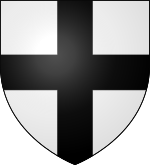 Coat of arms of the order | |
| Awarded by Pope Francis | |
| Type | Dynasty order of chivalry |
| Established | 1190 |
| Country | |
| Religious affiliation | Catholic Church |
| Ribbon | Black |
| Motto | Helfen, Wehren, Heilen |
| Grand Master | Frank Bayard |
| Grades | Honorary Knight |
| Statistics | |
| Total inductees | 11? |
| Precedence | |
| Next (higher) | Sovereign Military Order of Malta |
| Next (lower) | Pro Ecclesia et Pontifice |
Ribbon bar | |
Honorary Knights of the Teutonic Order have included:
- Konrad Adenauer
- Udo Arnold
- Franz Josef II
- Rudolf Graber
- Otto von Habsburg
- Karl Habsburg-Lothringen
- Joachim Meisner
- Eduard Gaston Pöttickh von Pettenegg
- Eduard Schick
- Christoph Schönborn
- Carl Herzog von Württemberg
Protestant Bailiwick of Utrecht
A portion of the Order retains more of the character of the knights during the height of its power and prestige. Der Balije van Utrecht ("Bailiwick of Utrecht") of the Ridderlijke Duitsche Orde ("Chivalric German [i.e., 'Teutonic'] Order") became Protestant at the Reformation, and it remained an aristocratic society. The relationship of the Bailiwick of Utrecht to the Roman Catholic Deutscher Orden resembles that of the Protestant Bailiwick of Brandenburg to the Roman Catholic Order of Malta: each is an authentic part of its original order, though differing from and smaller than the Roman Catholic branch.[41]
Insignia
| Wikimedia Commons has media related to Insignia of the Teutonic Order. |
The Knights wore white surcoats with a black cross, granted by Innocent III in 1205. A cross pattée was sometimes used. The coat of arms representing the grand master (Hochmeisterwappen)[42] is shown with a golden cross fleury or cross potent superimposed on the black cross, with the imperial eagle as a central inescutcheon. The golden cross fleury overlaid on the black cross became widely used in the 15th century. A legendary account attributes its introduction to Louis IX of France, who is said to have granted the master of the order this cross as a variation of the Jerusalem cross, with the fleur-de-lis symbol attached to each arm, in 1250. While this legendary account cannot be traced back further than the early modern period (Christoph Hartknoch, 1684), there is some evidence that the design does indeed date to the mid 13th century.[43]
The black cross pattée was later used for military decoration and insignia by the Kingdom of Prussia and Germany as the Iron Cross and Pour le Mérite.
The motto of the Order is "Helfen, Wehren, Heilen" ("to help, to defend, to heal").[10]
 14th-century brass stamp with the shield insignia.
14th-century brass stamp with the shield insignia. In the 16th century, officers of the order would quarter their family arms with the order's arms.[44]
In the 16th century, officers of the order would quarter their family arms with the order's arms.[44] Example of the Deutschmeisterwappen on the gate of the Bad Mergentheim residence
Example of the Deutschmeisterwappen on the gate of the Bad Mergentheim residence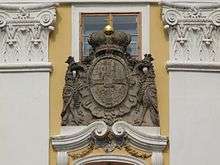 Coat of arms of Prince Charles Alexander of Lorraine, Grand Master from 1761 to 1780.
Coat of arms of Prince Charles Alexander of Lorraine, Grand Master from 1761 to 1780. Modern (20th century) medal
Modern (20th century) medal Procession in honour of Saint Liborius of Le Mans with Knights of the Holy Sepulchre together with Teutonic Knights in Paderborn, Germany.
Procession in honour of Saint Liborius of Le Mans with Knights of the Holy Sepulchre together with Teutonic Knights in Paderborn, Germany.
Influence on German and Polish nationalism
.jpg)
Emperor Wilhelm II of Germany posed for a photo in 1902 in the garb of a monk from the Teutonic Order, climbing the stairs in the reconstructed Marienburg Castle as a symbol of Imperial German policy.[45]
The German historian Heinrich von Treitschke used imagery of the Teutonic Knights to promote pro-German and anti-Polish rhetoric. Many middle-class German nationalists adopted this imagery and its symbols. During the Weimar Republic, associations and organisations of this nature contributed to laying the groundwork for the formation of Nazi Germany.[45]
Before and during World War II, Nazi propaganda and ideology made frequent use of the Teutonic Knights' imagery, as the Nazis sought to depict the Knights' actions as a forerunner of the Nazi conquests for Lebensraum. Heinrich Himmler tried to idealise the SS as a 20th-century reincarnation of the medieval Order.[46] Yet, despite these references to the Teutonic Order's history in Nazi propaganda, the Order itself was abolished in 1938 and its members were persecuted by the German authorities. This occurred mostly due to Hitler's and Himmler's belief that, throughout history, Roman Catholic military-religious orders had been tools of the Holy See and as such constituted a threat to the Nazi regime.[47]
The converse was true for Polish nationalism (see: Sienkiewicz "The Knights of the Cross"), which used the Teutonic Knights as symbolic shorthand for Germans in general, conflating the two into an easily recognisable image of the hostile. Similar associations were used by Soviet propagandists, such as the Teutonic knight villains in the 1938 Sergei Eisenstein film Aleksandr Nevskii.
Notes
- "Der Hochmeister".
- Van Duren, Peter (1995). Orders of Knighthood and of Merit. C. Smythe. p. 212. ISBN 0-86140-371-1.
- Redazione. "La Santa Sede e gli Ordini Cavallereschi: doverosi chiarimenti (Seconda parte)".
- Riley-Smith, Jonathan Simon Christopher (1999). The Oxford History of the Crusades. Oxford University Press. ISBN 9780192853646.
Teutonic knights are still to be found only in another interesting survival, Ridderlijke Duitse Orde Balije van Utrecht (The Bailiwick of Utrecht of the Teutonic Order). Like the Hospitaller Bailiwick of Brandenburg, this commandery turned itself into a noble Protestant confraternity at the time of the Reformation.
- Innes-Parker 2013, p. 102.
- American Historical Association, National Board for Historical Service, National Council for the Social Studies – 1918 : Historical outlook: a journal for readers, students and teachers
- "History of the German Order". Teutonic Order, Order of the Teutonic Knights of St. Mary's Hospital in Jerusalem. Archived from the original on 2011-07-18. Retrieved 2011-01-30.
The 15th and early 16th century brought hard times for the Order. Apart from the drastic power loss in the East as of 1466, the Hussite attacks imperilled the continued existence of the bailiwick of Bohemia. In Southern Europe, the Order had to renounce important outposts – such as Apulia and Sicily. After the coup d’état of Albrecht von Brandenburg, the only territory of the Order remained were the bailiwicks in the empire.
- Sainty, Guy Stair. "The Teutonic Order of Holy Mary in Jerusalem". Almanach de la Cour. www.chivalricorders.org. Retrieved 2011-01-30.
This tradition was further perverted by the Nazis who, after the occupation of Austria suppressed it by an act of 6 September 1938 because they suspected it of being a bastion of pro-Habsburg legitimism.
- "Restart of the Brother Province in 1945". Teutonic Order, Order of the Teutonic Knights of St. Mary's Hospital in Jerusalem. deutscher-orden.de. Archived from the original on 2011-07-18. Retrieved 2011-01-30.
- Demel, Bernhard (1999). Vogel, Friedrich (ed.). Der Deutsche Orden Einst Und Jetzt: Aufsätze Zu Seiner Mehr Als 800jahrigen Geschichte. Europäische Hochschulschriften: Geschichte und ihre Hilfswissenschaften. 848. Frankfurt-am-Main, Germany: Peter Lang. p. 80. ISBN 978-3-631-34999-1.
- Monumenta Germaniae Historica, SS Bd. 25, S. 796.
- Kurt Forstreuter. "Der Deutsche Orden am Mittelmeer". Quellen und Studien zur Geschichte des Deutschen Ordens, Bd II. Bonn 1967, S. 12f.
- The Teutonic Knights: A Military History by William Urban
- Seward, p. 100
- Seward, p. 104
- Christiansen, pp. 208–09
- Christiansen, pp. 210–11
- Barraclough, p. 268
- Urban, p. 106
- Christiansen, p. 211
- The German Hansa P. Dollinger, page 34, 1999 Routledge
- Plakans, Andrejs (2011). A Concise History of the Baltic States. Cambridge University Press. pp. 44–45. ISBN 9780521833721.
- SEWARD, Desmond (1995). The monks of war : the military religious orders (Second, Revised ed.). England: Penguin Books. p. 98. ISBN 0140195017.
- Christiansen, p. 150
- SEWARD, Desmond (1995). The monks of war : the military religious orders (Second, Revised ed.). England: Penguin Books. p. 100. ISBN 0140195017.
- HEERS, Jacques (1981). Esclaves et domestiques au Moyen Age dans le monde méditerranéen (First ed.). France: Fayard. ISBN 2213010943.
- The New Cambridge medieval history. McKitterick, Rosamond. Cambridge [England]: Cambridge University Press. 1995–2005. pp. 752. ISBN 0521362911. OCLC 29184676.CS1 maint: others (link) CS1 maint: date format (link)
- Urban, p. 116
- Christiansen, p. 151
- The Mongols and the West, 1221–1410, Peter Jackson, Routledge, New York, ç2018, p.66-78
- The Rise and Fall of the Second Largest Empire in History, Thomas Craughwell, Quayside Publishing Group, Massachusetts, ç2010, p.193-195
- Encyclopedia of Mongolia and the Mongolian Empire, Christopher Atwood, Indiana Univ. Press, Bloomington, ç2004, p.79
- Westermann, p. 93
- Christiansen, p. 248
- Seward, p. 137
- Urban, p. 276
- Dieter Zimmerling: Der Deutsche Orden, S. 166 ff.
- Der Deutschordensstaat
- Sainty, Guy Stair. "The Teutonic Order of Holy Mary in Jerusalem". Almanach de la Cour. www.chivalricorders.org. Retrieved 2011-01-30.
[T]he Nazis...after the occupation of Austria suppressed [the Order] by an act of 6 September 1938 because they suspected it of being a bastion of pro-Habsburg legitimism. On Germany's occupying Czechoslovakia the following year, the Order was also suppressed in Moravia although the hospitals and houses in Yugoslavia and south Tyrol were able to continue a tenuous existence. The National Socialists, motivated by Himmler's fantasies of reviving a German military elite then attempted to establish their own "Teutonic Order" as the highest award of the Third Reich. The ten recipients of this included Reinhard Heydrich and several of the most notorious National Socialists. Needless to say, although its badge was modelled on that of the genuine Order, it had absolutely nothing in common with it.
- Urban, p. 277
- Official website of the Bailiwick of Utrecht, accessed March 15, 2010
- The offices of Hochmeister (grand master, head of the order) and Deutschmeister (Magister Germaniae) were united in 1525. The title of Magister Germaniae had been introduced in 1219 as the head of the bailiwicks in the Holy Roman Empire, from 1381 also those in Italy, raised to the rank of a prince of the Holy Roman Empire in 1494, but merged with the office of grand master under Walter von Cronberg in 1525, from which time the head of the order had the title of Hoch- und Deutschmeister. Bernhard Peter (2011)
- Helmut Nickel, "Über das Hochmeisterwappen des Deutschen Ordens im Heiligen Lande", Der Herold 4/1990, 97–108 (mgh-bibliothek.de). Marie-Luise Heckmann, "Überlegungen zu einem heraldischen Repertorium an Hand der Hochmeisterwappen des Deutschen Ordens" in: Matthias Thumser, Janusz Tandecki, Dieter Heckmann (eds.) Edition deutschsprachiger Quellen aus dem Ostseeraum (14.-16. Jahrhundert), Publikationen des Deutsch-Polnischen Gesprächskreises für Quellenedition. Publikacje Niemiecko-Polskiej Grupy Dyskusyjnej do Spraw Edycij Zrodel 1, 2001, 315–346 (online edition). "Die zeitgenössische Überlieferung verdeutlicht für dieses Wappen hingegen einen anderen Werdegang. Der Modelstein eines Schildmachers, der unter Hermann von Salza zwischen 1229 und 1266 auf der Starkenburg (Montfort) im Heiligen Land tätig war, und ein rekonstruiertes Deckengemälde in der Burgkapelle derselben Festung erlaubten der Forschung den Schluss, dass sich die Hochmeister schon im 13. Jahrhundert eines eigenen Wappens bedient hätten. Es zeigte ein auf das schwarze Ordenskreuz aufgelegtes goldenes Lilienkreuz mit dem bekannten Adlerschildchen. Die Wappensiegel des Elbinger Komturs von 1310 bzw. 1319, ein heute in Innsbruck aufbewahrter Vortrageschild des Hochmeisters Karl von Trier von etwa 1320 und das schlecht erhaltene Sekretsiegel desselben Hochmeisters von 1323 sind ebenfalls jeweils mit aufgelegtem goldenem Lilienkreuz ausgestattet."
- In this example (dated 1594), Hugo Dietrich von Hohenlandenberg, commander of the bailiwick of Swabia-Alsace-Burgundy, shows his Landenberg family arms quartered with the order's black cross.
- (in Polish) Mówią wieki. "Biała leganda czarnego krzyża Archived 2008-02-27 at the Wayback Machine". Accessed 6 June 2006.
- Christiansen, p. 5
- Desmond Seward, Mnisi Wojny, Poznań 2005, p. 265.
External links
References
- Christiansen, Erik (1997). The Northern Crusades. London: Penguin Books. pp. 287. ISBN 0-14-026653-4.
- Seward, Desmond (1995). The Monks of War: The Military Religious Orders. London: Penguin Books. p. 416. ISBN 0-14-019501-7.
- Urban, William (2003). The Teutonic Knights: A Military History. London: Greenhill Books. p. 290. ISBN 1-85367-535-0.
- Selart, Anti (2015). Livonia, Rus' and the Baltic Crusades in the Thirteenth Century. Leiden: Brill. p. 400. ISBN 978-9-00-428474-6.
- Innes-Parker, Catherine (2013). Anchoritism in the Middle Ages: Texts and Traditions. Cardiff: University of Wales Press. p. 256. ISBN 978-0-7083-2601-5.
External links
| Wikimedia Commons has media related to Teutonic Order. |
- The order's homepage in Germany (in German)
- The order's homepage in Austria (in English)
- Territorial extent of the Teutonic Knights in Europe (map)
- An Historical Overview of the Crusade to Livonia, by William Urban
- "The Early Years of the Teutonic Order", by William Urban
- Museum in the residential castle of the Teutonic Order in Bad Mergentheim (in German)
- Zwaetzen and the German Order in Central Germany (in German)

